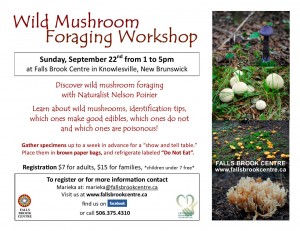Wild Mushrooms in New Brunswick
 It’s now mushroom season in the woods of New Brunswick and our fields and forests offer up a tasty buffet of edible wild mushrooms…if you know what you are looking for!
It’s now mushroom season in the woods of New Brunswick and our fields and forests offer up a tasty buffet of edible wild mushrooms…if you know what you are looking for!
Foraging for mushrooms is a time honoured event in many regions, with many mushrooms hunters jealously guarding the locations of prime harvesting spots.
In fact, wild mushroom harvesting is big business in some areas. Morel hunters can make hundreds of dollars a day selling this gourmet mushroom to markets and upscale restaurants.
No one has figured out a way to cultivate white morels, so the only sources are those that are harvested from the wild, just like truffles.
Most of us are a quite leery of eating wild mushrooms, but with the right knowledge you can safely enjoy some of Mother Earth’s most delicious bounty!
The following list are among the edible wild mushrooms that can be found in New Brunswick:
bear’s head tooth mushroom
black morel
chicken of the woods
comb tooth mushroom
common puffball
fairy ring mushroom
giant puffball
golden chanterelle (aka chanterelle)
hedgehog mushroom
horn of plenty (aka black chanterelle, black trumpet)
horse mushroom
ink cap
jelly ear (aka wood ear)
king bolete (aka cepe)
larch bolete
lobster mushroom
meadow mushroom
mica cap
oyster mushroom
red cracked bolete
saffron milk cap
scaly hedgehog
shaggy mane
slimy spike cap
yellow swamp russula
You can learn all about mushroom foraging with hands on experience and advice from Naturalist Nelson Poirier on September 22nd at Falls Brook Centre in Knowlesville.
Got a mystery mushroom you want to identify? If you attend the workshop, you are welcome to bring mushroom samples for identification that are up to a week old….just keep them in the refrigerator in a paper bag until you see Nelson.
Many species of mushrooms are utilized for their medicinal qualities. The lion’s mane mushroom, for instance, has halted and even reversed the symptoms of dementia and Alzheimer’s in test subjects.
It has what is called NGF, or Nerve Growth Factor, so that it actually has the ability to penetrate nerve tissue to facilitate healing.
In ancient China, this mushroom was so revered for both its unique flavour and healing qualities that only the ruling classes were permitted to use it!
This workshop will help you learn to safely identify wild mushrooms in our province.
S. Kelley
